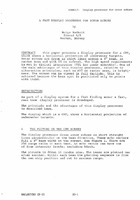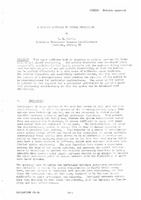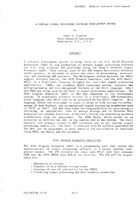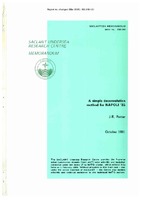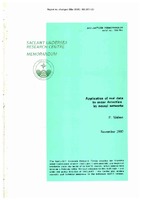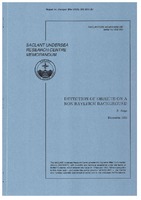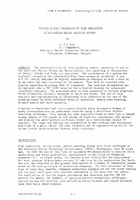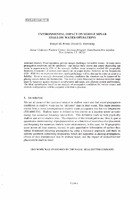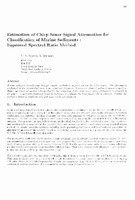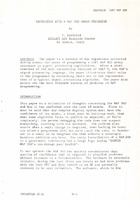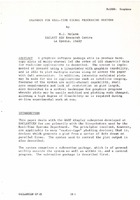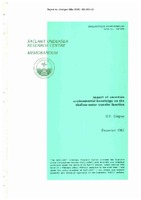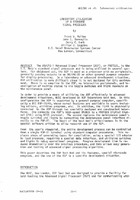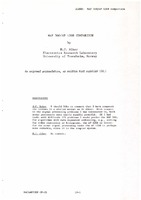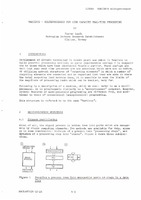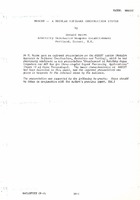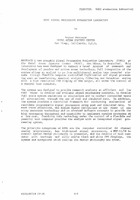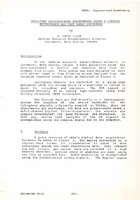Browsing by Subject "Sonar"
Now showing items 1-20 of 31
-
A fast display processor for sonar echoes
(NATO. SACLANTCEN, 1979/12)This paper presents a display processor for a CRT, which shows a horizontal projection of underwater targets. Sonar echoes are drawn as short lines across a 50 beam, in random scan and with 50 Hz refresh. The high speed ... -
A modular approach to signal processing
(NATO. SACLANTCEN, 1979/12)This paper outlines work in progress on modular systems for beamforming and signal processing. The modules described were developed using commercially available digital L.S.I circuits and the emphasis during development ... -
A modular signal processing software development system
(NATO. SACLANTCEN, 1979/12)A software development system is being built by the U.S. Naval Research Laboratory (NRL) to aid production of modular signal processing software for U. S. Navy airborne ASW platforms using the Navy's Advanced Signal Processor ... -
A simple deconvolution method for NAPOLI'85
(NATO. SACLANTCEN, 1991/10)An inverse filter (deconvolution in the frequency domain) is applied -
Application of real data to sonar detection by neural networks
(NATO. SACLANTCEN, 1992/11)This memorandum describes the results of applying an artificial neural network for the detection of target echoes. The present study is a continuation of work conducted in 1989 in which a three-layer artificial neural ... -
Detection of objects on a non Rayleigh background
(NATO. SACLANTCEN, 1995/12)Sector scanning sonar systems image the sea-bottom to detect objects that can be distinguished from the background structure of the seabottom. In current systems images are displayed and discarded as new image data become ... -
Development of military ARGUS computers and MOD bus for close-coupled signal processing applications
(NATO. SACLANTCEN, 1979/12)The next generation of Naval sonar systems will make extensive use of flexible programable modules to implement signal-processing algorithms. A number of UK Defence Establishments are engaged in a series of coordinated ... -
Digital signal processing of high resolution within-pulse sector scanning sonars
(NATO. SACLANTCEN, 1979/12)The characteristics of three scanning sonars, presently in use at the Admiralty Marine Technology Establishment, and operating at frequencies of 300kHz, 150kHz and 75kHz are described. The performance of a system for ... -
Environmental impact on mobile sonar shallow water operations
(NATO. SACLANTCEN, 1993/08)Shallow Water operations provide unique challenges for mobile sonars. In many cases propagation conditions can be optimized - our studies have shown that sound channeling can occur in approximately 75% of the strategic ... -
Estimation of chirp sonar signal attenuation for classification of marine sediments: improved spectral ratio method
(NATO. SACLANTCEN, 1997)Remote sediment classification through acoustic methods is of great interest for a few years. The attenuation coefficient of the transmitted wave is an important feature to characterize physical sediment layers properties. ... -
Experience with a MAP 300 array processor
(NATO. SACLANTCEN, 1979/12)The paper is a summary of the experience collected during almost two years of programming a CSPI MAP 300 array ' processor in signal processing applications. After a short overview of the most interesting features of SNAP ... -
Graphics for real-time signal-processing systems
(NATO. SACLANTCEN, 1979/12)A graphics software package able to produce hardcopy plots of multi-channel (of the order of 100 channels) data for real-time applications is described. The system is implemented at present using a lineprinter with graphics ... -
Impact of uncertain environmental knowledge on the shallow-water transfer function
(NATO. SACLANTCEN, 1992/12)It is assumed that the acoustic channel can be modeled as a linear time-invariant space-variant filter. In this case, from linear systems theory, it is known that the filter output, that is the predicted source signal ... -
Laboratory utilization of a standard signal processor
(NATO. SACLANTCEN, 1979/12)The AN/UYS-l Advanced Signal Processor (ASP), or PROTEUS, is the U.S. Navy's standard signal processor and is being utilized in several systems. For shipboard use, the ASP is used as a processor with no peripherals, generally ... -
MAP 300/AP 120B comparison
(NATO. SACLANTCEN, 1979/12) -
Martinus - multiprocessor for high capacity real-time processing
(NATO. SACLANTCEN, 1979/12)Development of circuit technology in recent years now makes it feasible to build powerful processing machines at quite considerable savings - in comparison to those which have been considered feasible earlier. These savings ... -
MASCOT - a modular software construction system
(NATO. SACLANTCEN, 1979/12) -
NOSC signal processing evaluation laboratory
(NATO. SACLANTCEN, 1979/12)A new acoustic Signal Processing Evaluation Laboratory (SPEL) at the Naval Ocean Systems Center (NOSC), San Diego, is described. This laboratory has been designed to support a broad program of research and development of ... -
Overview of the ADPS signal processor
(NATO. SACLANTCEN, 1979/12) -
Real-time expanded-band beamforming using a complex heterodyner and fast array processor
(NATO. SACLANTCEN, 1979/12)At the Defense Research Establishment Atlantic Dartmouth, Nova Scotia, Canada a data aquisition sytem been engineered to monitor and beamform data from element line arrays. This system has been designed to with either towed ...
